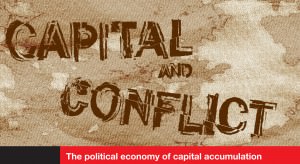Capital and Conflict in the Middle East
“Power is nothing but its effect and can only be known by its consequences.”
The political economy of capital accumulation
By Troy Redick, Staff Writer
The theme of the Arbitrage Magazine’s sixth issue is that of chaos, and its relationship to profit. However, there is evidence to support a decidedly un-chaotic, almost mechanical relationship between the profits of certain sectors and international armed conflict.
In a multitude of works, Political Economy professors Jonathan Nitzan and Shimshon Bichler illustrate that over a period of 40 years, the profit of a specific coalition of firms increased relative to that of the Fortune 500 immediately following every conflict in the Middle East. Furthermore, they show that such conflicts occur after periods when the group of firms they term the ‘Weapondollar-Petrodollar Coalition’ earns profits below that of the Fortune 500 average. This is a case of profiting directly from war and strife.
[pullquote]Every time profits hit a danger zone, there was an energy conflict and the differential profits of the Weapondollar-Petrodollar Coalition reigned supreme.[/pullquote]
The aggregate of the ‘Arma-Core’ and ‘Petro-Core,’ referred to by Nitzan and Bichler as the Weapondollar-Petrodollar Coalition, sees its profits rise in lock-step with international armed conflict, especially in the Middle East. The cause of this positive relationship between profit and war should be easy to guess when examining defense contractors and weapons companies – Nitzan and Bichler’s Arma-Core. However, the question remains as to why oil companies profit directly from conflict, and why such conflicts always erupt at times most convenient for the financial well-being of the firms comprising the Petro-Core.
As a student of both Political Economy and Finance, I found the authors’ explanation particularly eye-opening and felt compelled to share it. Anyone interested in the functioning of business and society would do well to explore this theory and broaden their perspective. The cause, according to Nitzan and Bichler, is capital as power and the method by which said power is accumulated and exercised.
Capital as Power and the Middle East
Commonly argued causes for conflict in the Middle East include American Imperialism, clash of cultures, anti-liberalism, religious wars, etc. It is perhaps true that the conflict in the area is fuelled in part by these undercurrents. However, Nitzan and Bichler found a pattern in quantitative empirical data, that when combined with their theory of capital as power, helps explain the conflictual nature of the Middle East with demonstrable proof.
The following image (taken from Nitzan and Bichler’s work) is a graphical representation of this fact. The horizontal axis represents the point at which oil and weapon companies realize profits equal to those of the S&P 500 average. Black bars represent a relative loss of profitability for the Weapondollar-Petrodollar Coalition compared to the S&P 500 (a danger zone for conflict); white bars represent the opposite. The explosion images represent a major conflict in the Middle East. As you can see, every time profits hit a danger zone, there was an energy conflict and the differential profits of the Weapondollar-Petrodollar Coalition reigned supreme.































Share the post "Capital and Conflict in the Middle East"